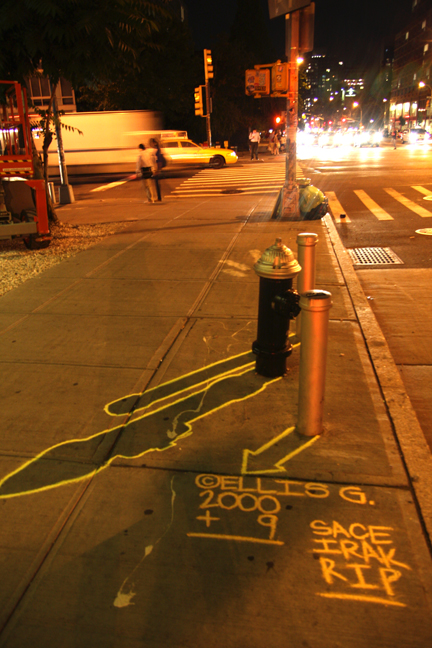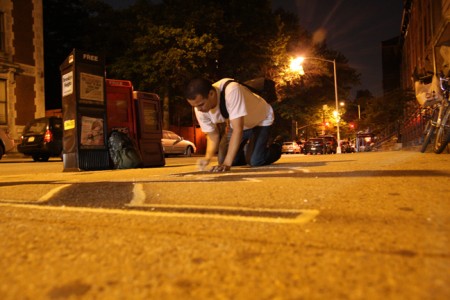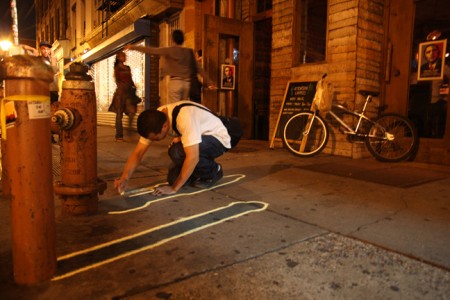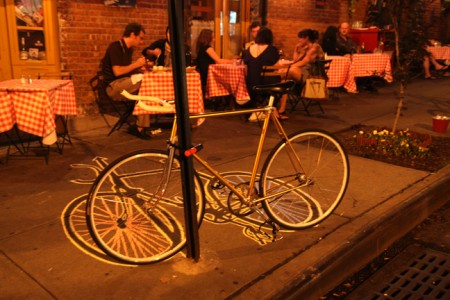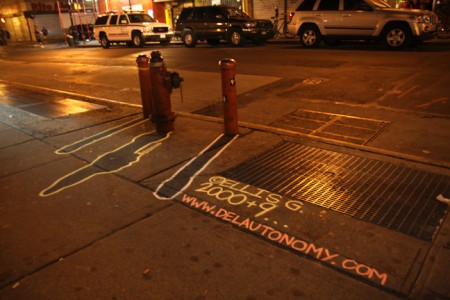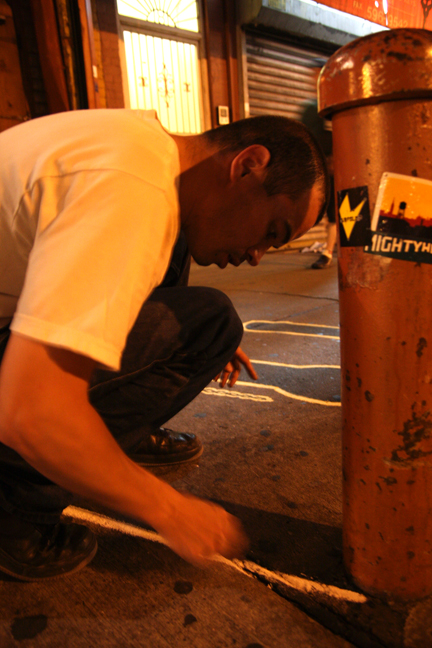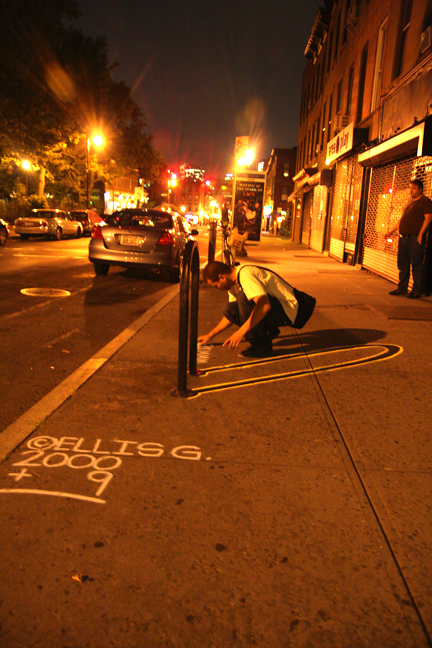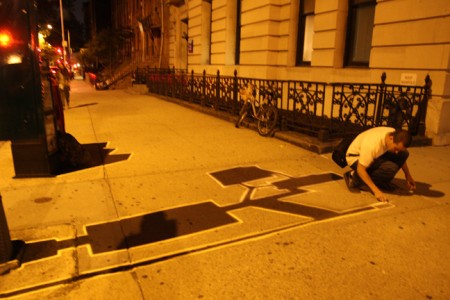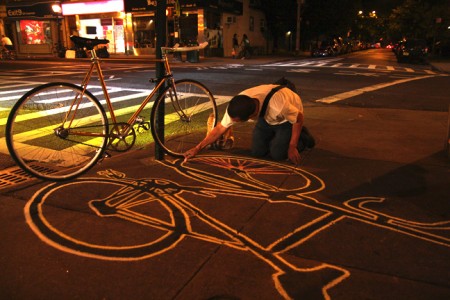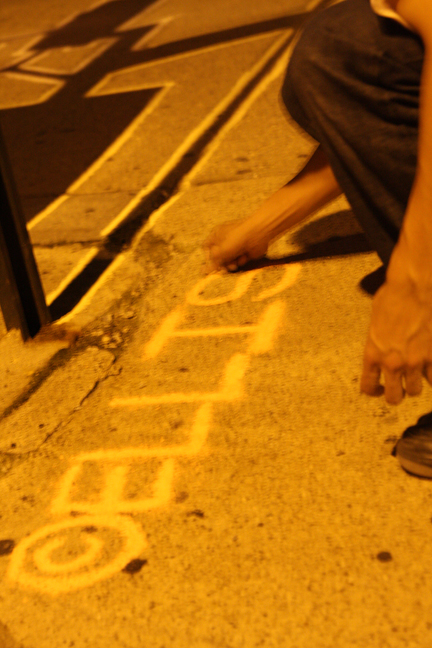AM had the chance to spend a few evenings with Ellis G. prior to his upcoming solo show “Ocular Echoism: The Autonomy of Ellis Gallagher” opening at Collective Hardware this Thursday, July 23 at 7pm in NYC. If you recall, we also had a chance to spend time with him on the streets before the group show he participated in at Thinkspace back in January.
As we walked the streets of Cobble Hill looking for the perfect subject/shadow, Ellis seemed to know a lot of people in the neighborhood. Some are friends and some are fans of “the sidewalk chalk guy” as one person called him when they stopped to watch him in action.
Our first spot of the evening were some newspaper boxes and a street/traffic pole. Not 10 minutes into his work, we got rolled up on by the cops. They got out of the car and saw that he was only using chalk and acknowledged that they’re fans of his other work they’ve seen on the street. This is a far cry from back in the day when he was arrested and taken into custody – luckily it was all caught on video and the charges were later dropped.
We continued and looked for the next spot, then the next one and the next one… Ellis’ love affair with the city continued throughout the night. Read our interview with Ellis as well as check out some of the images we captured of him hard at work after the jump…
Ellis Gallagher was born in Manhattan in 1973 and is a self taught artist. He comes from a graffiti background where he tagged for years but he mostly stopped tagging in 2001. It was at that point that a tragic incident woke him up a little bit. One night in 2001, Ellis and his friend Hector “HEC UFC” Ramirez got drunk and were bombing subway tunnels. Unfortunately, Hector got hit by a train that night. Ellis stopped to assess life, asking “Why am I doing this? What for? Myself? Other writers?” He needed to start thinking of the future, thinking about making a living from something that he liked to do and to start being more productive.
So he went inside the studio where he focused on collage and painting, primarily abstracts. Over time, he participated in a few group shows while working in restaurants waiting tables in order to get by. Nowadays, Ellis G. is still a graffiti writer at heart – he still reads it, writes it, breathes it and photographs it. Most of Ellis’ days consist of long hours at work, then hitting the streets at night with his bike and a plastic bag filled with chalk, often only getting a few hours of sleep. We had the chance to spend a few evenings with Ellis G. recently…
Arrested Motion (AM): Ellis, please tell us how you made the transition from graffiti artist to visual artist?
Ellis G. (EG): In 2005, I got into visual art/shadow based work. One night, I was returning home and was robbed in front of my house. I saw my attackers’ shadow. This developed into Post Traumatic Stress Disorder. In the days after, I felt like I had a heightened sense of awareness. I looked at shadows all the time. I saw shadows in a different way. One night walking home from my job, with some chalk I had in my pocket from writing the chalkboard menu earlier, I saw this fire hydrant and it’s shadow on the sidewalk and began to trace it. And that’s how it started. It started with a fire hydrant, then a tree, a bike, a fence, a parking meter, etc… I explored that road, night and day. It was like an instant response and acknowledgement. This is what I want to do. It was very different/opposite from working in the studio where no one sees it and you try to get people to see it via commissions and shows. The subject matter is never ending. Light is everywhere creating shadows. I capture and enhance it. One minute it’s here, the next it’s gone.
AM: That must have been a very traumatic experience for you. Did you feel that going out into the streets after that and recognizing shadows and accentuating them was therapeutic or a type of closure in some capacity?
EG: Yes. No doubt. I had to face my fear. I started hitting the streets more and more, doing my thing. As time went on I was starting to get more and more recognition. I was getting press in the NY Times, Time Out NY, various news channels and other media outlets. It was ON!
AM: Can you tell us some of your influences?
EG: Graffiti is my biggest influence, seeing other writers tags. This is what I was known for. To name a few specifically P13, OE-TMD, CHRIST 217, PRAY, RD-357, BS-119. I think P13 and OE-TMD had the most impact. They were everywhere, from the Eastside to the Westside, bathrooms, roof tops. I found it strangely appealing. What is it, why are they doing it and how?
My current day inspiration is NY. There are millions of people who each have their own agenda. So fast paced – tons of energy. The aesthetic makeup of city – it’s architecture, millions of people interacting from the ghastly slums to tycoon luxury. Human interaction, the human condition and engaging people in discussion is one of my motivations. “What is this for? Did someone die here? I hate this or looks great!” Any type of reaction you’re bound to get it. It’s a large part of what I do.
AM: What kind of variables come into play with your work?
EG: Subject, light, shadows, location and physical makeup of area, surrounding objects and surface.
AM: You recently had a very successful show in LA. How did the reactions differ from coast to coast?
EG: In LA there wasn’t too much adverse reaction. LA is very spread out and vehicular as opposed to NYC which is heavily pedestrian. My main focus was to put work out to be seen and photographed while out there.
AM: Can you tell us a little bit about your creative process?
EG: My signature logo on the street is my bike. Pink, white, blue chalk – white outline, spokes pink and blue. It depends on location. Usually I ride my bike around and sometimes log locations to come back to. Or I just freestyle it, get on my bike and go.
I like garbage night because there are more random objects on the street that cast shadows. Gotta mix it up and keep it fresh with light sources; from a building, store front, street light; different ways to create. Use of landmarks and familiar blocks and high pedestrian areas. My end result is a photograph with an enhanced shadow. Taking the ordinary/plain and bringing attention to it. Perhaps it makes you take a minute out of your busy day to question or notice something un-ordinary. To make someone stop and think and initiate a reaction, whatever that may be. It’s basically a romanticized notion/reaction – doing some random guys’ bike, for example. Maybe he’s in such a hurry, but he stops for a few seconds to see that some guy took the time out to do a shadow outline of his bike and that makes him think about that and maybe he should take the time out to realize something and reflect upon his thoughts and integrate it into his life. Maybe you should take the time out and do something for yourself. If i can make a difference in one person’s life, then I’m doing my job. I like to think I already have begun that process.
AM: How do you perceive being a recognizable artist?
EG: Art is a tough business. There are millions of artists. Everyone has a gimmick trying to stand out from the rest. Unfortunately, it’s not just about the artist’s work or character, but a combination of both. Everybody has something with their own twist/style thrown on it. I like to make work that makes an impact, that effects and engages people, that makes people question – is it the art or the making of the art that is the art because it’s temporary in the street, hosed away, worn away from pedestrian traffic, rain, etc.
AM: Please tell us about your upcoming solo show and the meaning of the show’s title “Ocular Echoism: The Autonomy of Ellis Gallagher.”
EG: The show is on Thursday, July 23, 2009 at Collective Hardware called “Ocular Echoism – The Autonomy of Ellis Gallagher” and is presented by the De L’Autonomy Mission (Kimberly de Los Angeles; curator for the show and the director for the De L’Autonomy Mission). Ocular is visual and my work is a visual echo. You have a bike, or handrail, or ladder, with some light on it and there’s a shadow that I enhance with chalk. It’s a visual echo. An ocular echo. I came up with it in 2006. There ya go – going back to gimmicks. I kind of abandoned it for a few years and now am bringing it back to the roots of what it was/is. Bringing it back to the basics. Be on the lookout for more artists to come out of the De L’Autonomy Mission in the near future.
AM: What is the general vibe of the show gonna be like?
EG: Snippets of time, tastefully capturing moments of how I see it on the streets. Everyone sees things differently. My view on how important the city, people, culture is to me; the physical makeup of the city. I can’t stress it enough. It’s comforting to me because it’s familiar. I grew up here, aware of my surroundings and familiar with them. Yeah, the show is capturing moments, how I see stuff and enhance the NYC streets; those moments that are captured – temporary/fleeting.
AM: How will you bring the outside inside for the show?
EG: Through photography of my street work, screen prints of my photography of my street work and mixed media installations. Basically, bringing the streets/outdoors inside – garbage cans/bags, newspaper boxes, bikes, all types of shit from the outside. The focus will on lighting to create shadows. I’ll paint walls and floors, garbage everywhere, hang shit from the ceiling, turn this place out. I’m excited about the install.
AM: Will you be doing anything on the streets outside in the neighborhood?
EG: Yeah, no doubt! I’ll be doing stuff on the streets in the neighborhood leading up to the opening promoting the show/website.
AM: What are your thoughts/aspirations/expectations from your first NYC solo show?
EG: I’ve been in plenty of group shows… Bars, restaurants… They don’t count. Now, it’s time for a proper gallery solo show. I’m really excited. I love the challenge. I think I’m over the stress of producing work. I know what I need to do. I write out my plan of attack, then execute. I’ve got most of the photography done. I’m just really excited to turn this place out, have a lot of people come and enjoy the opening/my work and go home happy. I don’t really have any expectations besides people having a good time and enjoy themselves. Have a little impact on someone and maybe they will buy a piece of my work to take home with them.
AM: What do you want people to leave here with?
EG: That was a dope show! This is definitely my most ambitious work to date. I had a pretty rigorous production schedule. I set out to achieve a goal which was to do a series of different objects and I conquered it. I had a “to do” list, get something done, check it off, next. For example, tonight I’m going to LES and doing fire hydrants, or I’m gonna go to the East Village to do some bicycles, or going to Brooklyn to do some garbage cans in Williamsburg. That’s how it goes. I want it to be more loose. It’s gonna be really mixed up and a good variety of work.
AM: Seems like people have a hard time with the fine line and seeing the difference between street/visual art and graffiti art.
EG: Coming from graffiti, it’s a weird position being a street/visual artist. Some people from my graff past don’t accept it. They’re graffiti purists, graffiti being a letter and name based art form. With some of them, there’s no overlap. You have your old masters that led the way, which is part of the logical progression of being a visual artist. Graff and street art has infiltrated every facet of pop culture from advertising, to fashion, film, comic books, urban vinyl. When you just say you’re a visual artist, it doesn’t paint the whole picture. The graff writers and street artists should respect each others’ work even though its a fight for space. The code of ethics just gets thrown out the window. At the end of the day, It’s all visual stimulation. Everyone has their own opinion or taste. That’s cool, that’s dirty, that’s vandalism. It’s beautiful but illegal, why is it there?
AM: If you had unlimited budget and time was not an issue, what grand artistic vision would you look to bring to life?
EG: Fuck. I’d like an airport hanger full of all different aircraft – 727, 747, F16 jet fighters, the space shuttle, Cessna’s, helicopters, all types of machines that fly. Throw some crazy lights up with gels and have these crazy colors in the hanger flowing from the top, colors graduating from one to the next. I actually kind of pitched this idea to someone at one point.
AM: What does the future hold for Ellis G.?
EG: Next up for me this fall is the First Annual Suffern Art and Music Festival with photographer Spencer Tunick in upstate NY and a window display. There will be plenty of nude woman and I’ll do shadows of naked people in his driveway. I also have a show planned in Beijing, some group shows, the Willoughby Windows Project, a show in Boston with Dirty Pilot in the beginning of 2010 and some various freelance/commercial work. Essentially, my goal is to create more work and branch out internationally – commissions, send out proposals to galleries, museums. I would love to do some traveling in the future. Hopefully ,the commissions bring me out there all over the world to create work. In the meantime, I’ll continue to hit the streets.
Shout outs to my fallen “graff” soldiers out there R.I.P: Dash Snow/Sace-IRAK, HEC-UFC, Joey SEMZ, Harold Hunter, ELF-MPC, DRONE-RTW, DIRT-TVOD.
Also to my son Kieran and to my family. Big shout out to Joe Russo and ArrestedMotion.com, Seth and Elisa Carmichael of the Carmichael Gallery, Hyland Mather of Mather/Kunst, Andenken Gallery, Don Flores, Andrew Hosner of Thinkspace Gallery, Mikal Hameed, COST-KRT, SET-KRT, JON-156, PONE-156, TATU-XMEN, CYCLE TC5.
Interview conducted by Joe Russo (AM-NY) with some additional questions from Andrew Hosner.
Discuss this show here.





